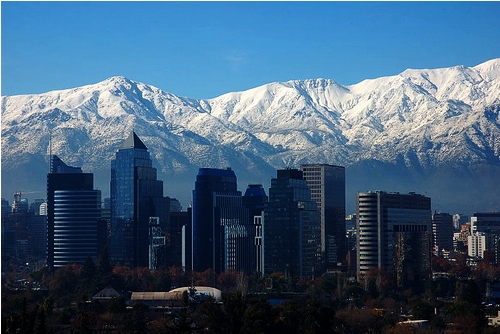Return circuit: Santiago
[south-america A tight flight
Our flight from Lima to Santiago de Chile was an early one as it was an international flight and immigrations and security was not known to be efficient. The check-in at lima airport was surprisingly efficient and Sky Airlines, a Chilean carrier was the first ‘budget’ airline we were taking on this trip. On the surface the airline looked very modern with new planes, attentive ground staff and reasonably on-time departures (at least in our case).
However on boarding we noticed that the leg-space (rather typical in most budget carriers) was a lot tighter than our previous flights within South America. So it was an uncomfortable 4 hour flight and we were glad when we landed at Santiago to stretch our cramped legs. I wasn’t aware of an upgrade option but given the duration of the flight (almost 3 hours), longer-legged travellers might which to buy extra leg space to avoid the cramps.
Smog screen
When looking up photos of Santiago you’d see a modern city with the Andes mountains in the background.
 credit:interNations.
credit:interNations.
Unfortunately when we arrived this stunning backdrop was obscured by a dense haze with a yellowish-tinge. The taxi driver told us this was caused by air pollution, though I couldn’t discount the possibility of some seasonal climatic effect, like in the case of the white alabaster skies of Lima.
Checkin
We booked a service apartment at CLH Suites which ran a dorm for backpackers below. The hostel had bright hipster vibe similar to the hostel I stayed on my 1st night in Buenos Aires. Though that was an old apartment building in the town centre whereas this was a modern building. The common areas below was noisy with the chatter of backpackers of different languages as was the dining area. We deposited our luggage in our surprisingly large apartment and prepared to head out to explore the city sights.
European character
Like its eastern neighbour Argentina, Chile was a mostly European-influenced nation with a greater portion of European immigrants and a smaller indigenous population. The people of the Atacama in northern Chile resembled the indigenous peoples whereas as a large city like Santiago appeared to have a more European population and this was reflected in the architecture of the city centre.
Good wine and Meats
Like Argentina, Chilean cuisine was well known for its grilled meats and good wines. There was no shortage of dining options on our walking route through the city.
Again cuisine in this part of South America had a strong Italian influence given the migration pattern which mirrored Argentina.
Unlike Peru, Santiago’s dining options were less influenced by native foods (like quinoa, alpaca meat or a wide variety of tubers) so probably more familiar to the average westerner.
City park
We decided to explore the nearby park of Santa Lucía Hill which was within walking distance from the central plaza (Plaza de Armas) of the city.
The slope ascended at a slight angle and made for a comfortable walk. The park was near a Chilean university so most of the walkers being students rushing about with books (and a solitary tramp sleeping by the footpath).
Plaza
The central square of the city (Plaza de Armas) which is a common feature of almost every Hispanic town we visited had the grander monuments , fountains and some of the older colonial buildings of the city.
Santiago is said to be one of the most modern globalized cities in South America and was an early adopter of open free market policies in the region. With this in mind i’d expected the majority of the city to be shiny glass & steel skyscrapers but most of the buildings i encountered was of an older European architecture (late 19th or early 20th century).
Some mounted police officers were in the plaza but the air of this city was very calm and orderly.
Conclusion
We only had a day stopover in Santiago and people with more time on their hands would probably explore the surrounding vineyards and fine national parks outside Santiago. Chile’s infrastructure was quite modern compared to her northern neighbours and appeared to be economically vibrant. Crime was less of concern here compared to other cities but the usual caution against pickpockets and muggings should be observed.
The next morning we’d be heading to our final stop on this 1 month of travel: Buenos Aires, Argentina.